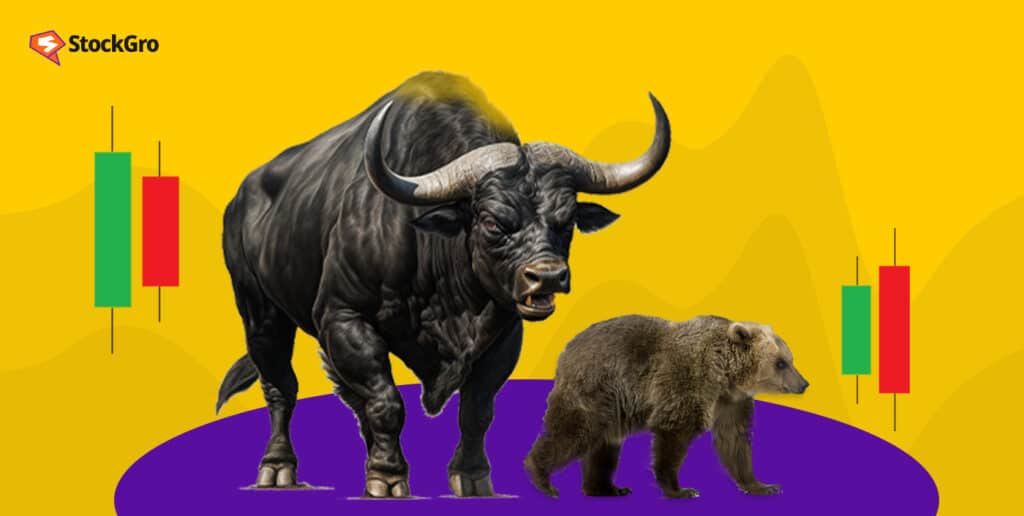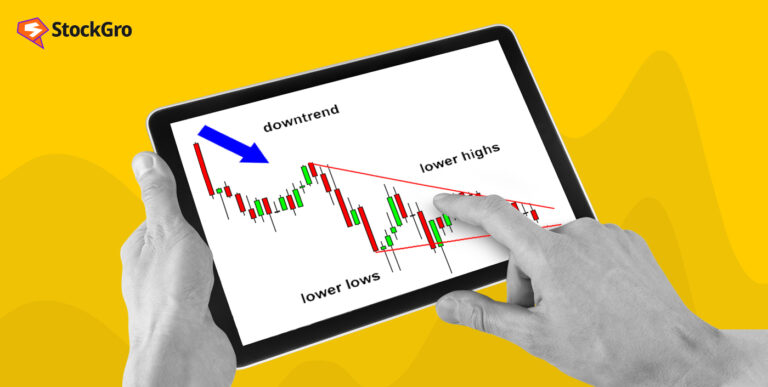
Price movement comes with trading opportunities in the financial markets. Traders need technical analysis tools to identify potential price movements and understand how to capitalise on them.
For technical analysis, candlestick formations stand out for their ability to provide a clear message of approaching trend reversals. One of the powerful candle patterns is the bullish engulfing with its distinct visual representation. Read this Beginner’s Guide to Candlestick Patterns in Stock Trading.
In this article, you can understand the power of a bullish engulfing candlestick pattern and how to interpret signalled price reversal.
What is Bullish Engulfing Candlestick Pattern
The Bullish Engulfing is a multiple candlestick pattern representing a reversal of the ongoing market trend. It appears at the bottom of a downtrend and involves the interplay of two candles.
You may also like: Deciphering the rising wedge pattern in stock trading
As the name suggests, an engulfing candle pattern is when a candle in a price chart completely engulfs or covers the previous candle. The first candle reflects the recent trend’s colour (red), while the second candle (green) is of the opposite colour and suggests a potential reversal of the ongoing trend.
The bullish engulfing candle typically appears after a long downward price trend. This downtrend sets the stage for an approaching trend reversal, indicating reduced selling pressure and a rise in buying pressure. It triggers more buyers to enter the market, leading to a further price rise.
Bullish vs. bearish engulfing pattern
A bearish engulfing pattern signals a bearish reversal that suggests a potential price fall as sellers take charge. This pattern emerges at the top of an uptrend. It is characterised by the force of selling pressure exerted by sellers. Explore the dynamics of the bull vs bear market and learn effective strategies to thrive in both bullish surges and bearish downturns.
This pattern triggers a reversal of the existing trend, prompting an inrush of sellers that drives the price downward.
Components of bullish Engulfing Candle pattern
First candle:
The first or previous candle in the bullish engulfing pattern is the bearish one of a downtrend. This bearish candle indicates that the opening price is higher than the closing price.
Traders look at the body size to get a signal. A large sized body indicates a significant fall in price during the specified time frame, representing an existing downtrend.
Also Read: Between bulls and bears: The power of the flag pattern in trading
Second candle:
The second candle is bullish in the bullish engulfing pattern. It engulfs the first candle’s body (bearish candle). It means this bullish candle opens lower than the closing price of the first candle.
But, when it closes, it is above the first candle’s opening price. The second candle’s body is typically longer than the first, indicating a significant change in market sentiment.
Interpretation and signals
The bullish engulfing pattern is used to spot early price shifts and market sentiment. Here is how bullish engulfing is interpreted:
- Market sentiment: Simply, it can have a huge impact on market sentiment as it can prompt traders to take positions, expecting a price increase. The bullish engulfing pattern illustrates changing market sentiment from a bearish outlook to a bullish one.
A sharp price direction shift represents buyers’ increased control and potentially reversing the existing downtrend.
- Candle size for confirmation: The candle size in every candlestick pattern matters and enhances the reliability of the signal. In the engulfing pattern, a larger bullish candle than the prior bearish candle indicates a significant change in prices and a shift in market sentiment.
A large-sized bullish candle represents that buys have significantly overcome the sell, marking a strong bullish reversal.
How to trade Bullish Engulfing pattern
As traders recognise a bullish engulfing pattern, they often initiate long positions (buying securities with expectations of price rise), buying the asset with the expectation that the price will rise. The pattern’s occurrence suggests holding the securities for future sale at a higher price.
It is essential to note that traders do not solely rely on the bullish engulfing candles to avoid any lack of flexibility in their trading strategies. They consider diversifying analysis methods with other crucial market signals to mitigate the risk.
Also Read: Insights into market trends and reversals using Inverted Hammer
Often, they find a bullish engulfing pattern, a strong signal, when the red candle is a doji or the following candles close above the high of the bullish candle.
Example
As previously mentioned, the bullish engulfing pattern appears at the end of a downtrend, signifying the potential new uptrend. A trend reversal implies that there is the need for a correction of an upward trend first. In the provided chart, you can observe an upward trend (from January to February) that led to a 100% surge in price.
Chart 1
Subsequently, a trigger is required to reignite the previous upward movement. In chart 2, notice how the price swiftly surged after a short-term move against the prevailing trend (partial retracement) on February 28th.
Observe how the bullish candle engulfed the preceding candle completely, an indication of a bullish reversal.
Chart 2
Bullish Engulfing Candle Reversals
The bullish engulfing candle is a key pattern for spotting trend reversals early, but it’s even more powerful when combined with other market indicators. Imagine this scenario: the market has been in a downtrend for a while, and you’re waiting for a sign that the trend might change.
When a bullish engulfing pattern appears, it suggests a sudden shift in momentum—from sellers having control to buyers stepping in forcefully. The idea here is simple: the larger green candle “engulfs” the previous red candle, indicating that buyers are now stronger than sellers, at least in the short term.
This kind of reversal is a heads-up that the market sentiment could be changing, which could lead to more buyers entering the market and pushing prices even higher. For traders, spotting this momentum shift early is crucial as it gives you the opportunity to catch a price move before it really takes off.
However, keep in mind that not every bullish engulfing pattern guarantees a successful reversal. The best way to increase your chances of success is to combine this pattern with other indicators like support levels or volume confirmation. This way, you’re not just reacting to a single signal but getting a more reliable picture of what might come next.
Conclusion
The bullish engulfing pattern is a crucial concept in technical analysis to forecast potential price trends and market shifts based on historical market data.
By recognising this pattern and understanding its implications, traders can stay ahead of their counterparts to benefit from market shifts. Understanding market shifts will help you make more money, both when investing and trading in equity.
Combine its signs with other analysis tools or techniques and boost its effectiveness.

